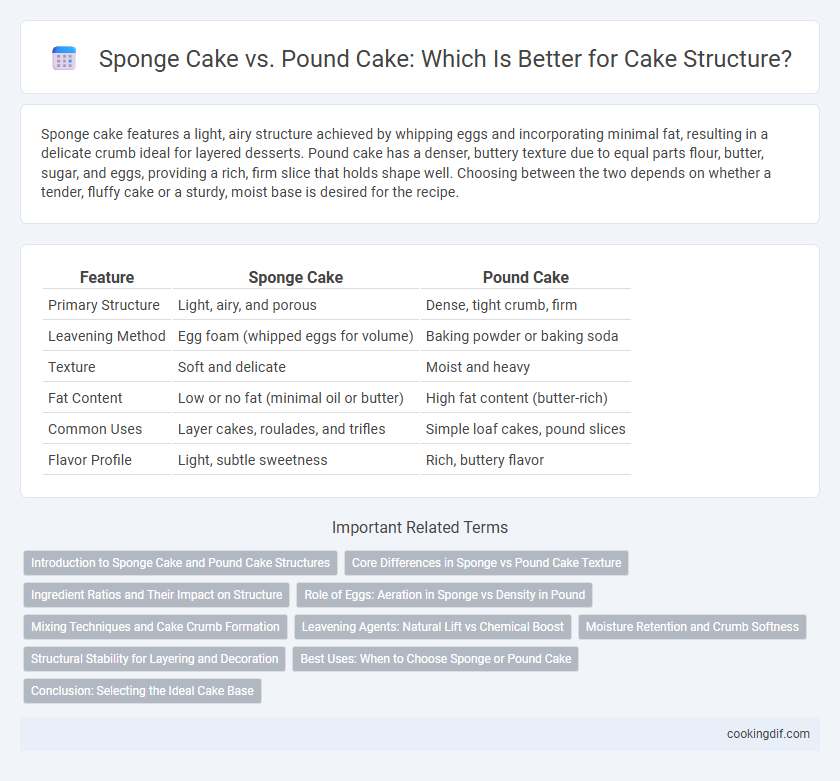Sponge cake features a light, airy structure achieved by whipping eggs and incorporating minimal fat, resulting in a delicate crumb ideal for layered desserts. Pound cake has a denser, buttery texture due to equal parts flour, butter, sugar, and eggs, providing a rich, firm slice that holds shape well. Choosing between the two depends on whether a tender, fluffy cake or a sturdy, moist base is desired for the recipe.
Table of Comparison
| Feature | Sponge Cake | Pound Cake |
|---|---|---|
| Primary Structure | Light, airy, and porous | Dense, tight crumb, firm |
| Leavening Method | Egg foam (whipped eggs for volume) | Baking powder or baking soda |
| Texture | Soft and delicate | Moist and heavy |
| Fat Content | Low or no fat (minimal oil or butter) | High fat content (butter-rich) |
| Common Uses | Layer cakes, roulades, and trifles | Simple loaf cakes, pound slices |
| Flavor Profile | Light, subtle sweetness | Rich, buttery flavor |
Introduction to Sponge Cake and Pound Cake Structures
Sponge cake features a light, airy structure achieved by whipping eggs and incorporating air, resulting in a tender crumb and high volume. Pound cake relies on a dense, moist texture obtained through a traditional ratio of equal parts flour, butter, sugar, and eggs, producing a firm and rich crumb. The distinct preparation techniques define their structural differences, with sponge cake emphasizing leavening through egg aeration and pound cake emphasizing fat and sugar content.
Core Differences in Sponge vs Pound Cake Texture
Sponge cake features a light and airy texture due to the incorporation of whipped eggs, which create a delicate crumb structure with ample air pockets. Pound cake has a denser and buttery texture resulting from a higher fat-to-flour ratio and the creaming of butter and sugar, producing a tight, moist crumb. These core differences in texture make sponge cake ideal for layered desserts and pound cake perfect for slicing and serving standalone.
Ingredient Ratios and Their Impact on Structure
Sponge cake relies on a higher ratio of eggs and minimal fat, which creates a light, airy structure due to the aeration of egg proteins during whipping. Pound cake contains equal parts of flour, butter, sugar, and eggs, resulting in a denser, buttery texture with a tight crumb caused by the higher fat content stabilizing the starches. The ingredient ratios directly influence moisture retention and crumb density, with sponge cakes favoring volume and pound cakes emphasizing richness and firmness.
Role of Eggs: Aeration in Sponge vs Density in Pound
Eggs in sponge cake act as the primary leavening agent, whipping air into the batter to create a light, airy structure characterized by delicate, open crumbs. In pound cake, eggs contribute more to density and richness, providing moisture and binding without significant aeration, resulting in a denser, fine-textured crumb. The contrast in egg usage directly influences the cakes' differing textures, with sponge cakes relying on egg foam for volume and pound cakes depending on eggs for moisture and firmness.
Mixing Techniques and Cake Crumb Formation
Sponge cake relies on whipping eggs to incorporate air, creating a light and airy structure with a delicate crumb, while pound cake uses creamed butter and sugar to trap tiny air bubbles, resulting in a dense, moist texture with a tight crumb. The mixing technique in sponge cake involves gentle folding to preserve aeration, whereas pound cake requires vigorous creaming to develop the proper crumb formation. This difference in mixing fundamentally affects the cake's rise, crumb uniformity, and overall mouthfeel.
Leavening Agents: Natural Lift vs Chemical Boost
Sponge cake relies primarily on natural leavening from whipped egg whites, creating a light and airy structure with delicate crumb texture. Pound cake uses chemical leavening agents like baking powder or baking soda to provide a consistent rise and denser, moist crumb. The choice of leavening drastically influences the cake's texture, with sponge cake exhibiting a softer, more porous interior compared to the pound cake's firmer, tighter crumb.
Moisture Retention and Crumb Softness
Sponge cake features an airy, porous structure that excels in moisture retention, resulting in a light and tender crumb. Pound cake, with its dense and buttery texture, offers a richer mouthfeel but may retain moisture less effectively, leading to a firmer crumb. The contrast in their baking techniques determines the subtle differences in softness and moisture, where sponge cake emphasizes aeration and pound cake relies on fat content.
Structural Stability for Layering and Decoration
Sponge cake features a light, airy structure with high porosity, making it ideal for absorbing syrups and delicate layering but offering moderate stability for heavy decorations. Pound cake presents a dense, tight crumb that provides superior structural stability, supporting multiple layers and intricate decorations without collapsing. When constructing multi-tiered cakes, pound cake's robust texture reduces the risk of sagging, whereas sponge cake requires careful reinforcement to maintain shape and support.
Best Uses: When to Choose Sponge or Pound Cake
Sponge cake's airy, light structure with large air pockets makes it ideal for layered cakes that require soaking syrups or delicate fillings like whipped cream or fruit. Pound cake's dense, buttery crumb holds up well to rich frostings and sturdy decorations, making it the best choice for bundt cakes or simple, unfrosted slices. Choose sponge cake for desserts needing a tender texture that absorbs moisture, while pound cake suits recipes demanding firmness and a rich, buttery flavor.
Conclusion: Selecting the Ideal Cake Base
Sponge cake offers a light, airy structure with high volume due to its whipped egg components, making it perfect for delicate, layered desserts. Pound cake features a dense, buttery crumb resulting from equal parts of flour, sugar, butter, and eggs, ideal for rich, sturdy bases. Selecting the ideal cake base depends on the desired texture and application, with sponge cake suited for softness and rise, while pound cake excels in firmness and moisture retention.
Sponge cake vs Pound cake for cake structure Infographic

 cookingdif.com
cookingdif.com